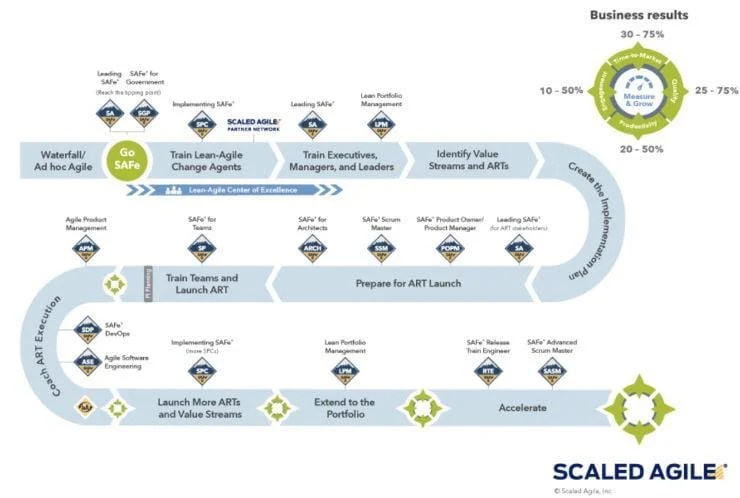
The Scaled Agile Framework® (SAFe®) is a set of workflow and organization patterns for implementing Agile Practices at an Enterprise level. The framework encompasses a set of principles, processes and best practices that helps organizations adopt agile methodologies, such as Lean and Scrum, to develop and deliver high-quality products and services faster.
SAFe promotes alignment, collaboration, and delivery across large numbers of agile teams. It was developed by and for practitioners, by leveraging three primary bodies of knowledge: agile software development, lean product development, and systems thinking.
At the time of writing this article, is in currently in Version 5.0, which was released in January 2020.
The SAFe Principles
SAFe is built on the following immutable lean and agile principles:
- Take an economic view
- Apply systems thinking
- Assume variability; preserve options
- Build incrementally with fast, integrated learning cycles
- Base milestones on objective evaluation of working systems
- Visualize and limit WIP, reduce batch sizes, and manage queue lengths
- Apply cadence, synchronize with cross-domain planning
- Unlock the intrinsic motivation of knowledge workers
- Decentralize decision-making
- Organize around value
SAFe Framework
SAFe Version 5.0 essential has the following 4 configurations:
- Essential SAFe: This is the most basic configuration. It describes the most critical elements needed and is intended to provide the majority of the framework’s benefits. It includes the team and program level (which it calls agile release trains or ARTs)
- Portfolio SAFe: Earlier known as Value Streams; This allows for coordination and synchronization across multiple programs, but without the portfolio considerations.
- Large solution SAFe: This includes concerns for strategic direction, investment funding, and lean governance.
- Full SAFe: As the name suggests, this encapsulates all the above three configurations.
SAFe Implementation
SAFe provides an implementation roadmap to guide enterprise who are ready to adopt it. It is a 12-step process that covers the following:
- Reaching the tipping point
- Train lean-agile change agents
- Train executives, managers, and leaders
- Create a lean-agile center of excellence
- Identify value streams and ARTs (Agile Release Trains)
- Create the implementation plan
- Prepare for ART launch
- Train teams and launch the ART
- Coach the ART execution
- Launch more ARTs and value streams
- Extend to the portfolio
- Sustain and improve

SAFe Certifications
There are several SAFe certifications available. It is best recommended to read the available certifications in your region by visiting their website.
Scrum Vs SAFe
Scrum and SAFe both function under the Agile values and principles. They are quite similar but do have some minor differences which are worth knowing.
| # | SAFe | Scrum |
|---|---|---|
| 1 | Recommended for large, multi-geography teams | Recommended for small, co-located teams |
| 2 | Basic construct is the Agile Release Train (ART) | Basic construct is the Scrum Team |
| 3 | SAFe incorporates Program and Portfolio Management since it deals with large teams | Scrum does not have any references to Program and Portfolio Management |
| 4 | SAFe needs to be adopted at the Enterprise level | Scrum can be adopted as a project-level (A scrum team) |
You may wish to look at Agile for Large Teams for alternative frameworks you can consider for large teams.
SAFe criticism
While there are many success stories of SAFe, there are many that critic it too.
- Beware SAFe (the Scaled Agile Framework for Enterprise), an Unholy Incarnation of Darkness
- Why SAFe is not the Scaled Agile approach you need
Is SAFe for me?
This is a decision that needs to be taken at the Enterprise Level. You need to ensure there is a buy-in from the Executive Leadership. You need to decide if this is something that can be implemented across the organization and not just at a team level. If you’re looking at Agile for just a handful of teams, look at frameworks like Scrum rather than SAFe.






